Effects of plastic mulching film-induced leaf burning on seedling growth in tobacco cultivation: Different findings beyond conservation view
Upland Flue-Cured Tobacco Quality and Ecology Key Laboratory of China Tobacco, Guizhou Academy of Tobacco Science,Guiyang 550081, P.R.China
1. lntroduction
Plastic mulching film supports higher soil temperature in the early time of a year in midwestern and northern regions of China (Zhouet al. 2009; Liuet al. 2014), which is correlated with early growth (Lament 1993; Hancock and Simpson 1995; Lietenet al. 2002) and extending of the fruit harvest periods in strawberry, for example (Masny and Zurawiez 2015). It generates a suppressive effect on weeds (Schonbeck 1999), and lower amounts of herbicides are needed. The evaporation of water is reduced under plastic mulches, with significant economic benefits for farmers (Ingmanet al. 2015; Jabranet al. 2016). Due to these advantages, polyethylene covers other mulching materials, and the use of plastic mulching in the cultivation of corn (Zea maysL.), cotton (Gossypium hirsutumL.),and spring and winter wheat (Triticum aestivumL.) has increased significantly (Liet al. 2004; Wanget al. 2016).In general, polyethylene sheets are used in a ridge-furrow system as continuous coverage in the field for the cultivation of strawberry (Mu?ozet al. 2017).
Tobacco is an important economic plant in China, and the principal production areas of tobacco are concentrated in remote rural areas with less developed economies.Essential poverty relief and increased income come from tobacco planting in such areas. Early transplanting and rapid growth after transplanting are important due to the variable climate conditions in the tobacco growing period and economic gains for the aftercrop in the double cropping area in southwestern of China. A well-cellar style transplanting(WCST) method in the subsurface of plastic mulching film in a ridge-furrow system was first developed in the Tongren area of Guizhou in 2009 (Linet al. 2015). For conventional transplanting, ridges were formed first and covered by plastic mulching film, and seedlings were planted on the surface of the ridges. However, for the WCST method, planting holes(well-cellar) with a diameter of 10 cm and a depth of 19–21 cm were first made at the top of the ridges after plastic mulching film covered, as described previously in details by Linet al.(2015), and seedlings were planted in the planting holes.Handicaps for tobacco seedling transplanting, such as low temperature, drought and less sun shining in early spring in tobacco cultivation areas of southwestern of China, were overcame by this transplanting method. It covered a total area of approximately 719 000 ha in tobacco cultivation and 130 000 ha inZea mays,Capsicum annuumandLycopersicon esculentumcultivation in a short period of time(Linet al. 2015). However, there are still disadvantages to this practice, such as young leaves of the plants becoming burnt by the high-temperature plastic mulching film at noon on a sunny day, which was always thought to be detrimental for plant growth and development and may lead to a drastic reduction in economic yield (Wahidet al.2007). Being influenced deeply by this belief, burnt leaves were always plucked from the subsurface of the plastic mulching film manually, which is time-consuming and labour-intensive.
Moreover, the current literature about plastic mulching in crop cultivation is mainly oriented to the effects on water conservation, increased soil temperature and product yield and quality (Wanget al. 2016; Zhanget al. 2016). However,relatively little has been published on the effects of leaf burning arising from high-temperature plastic mulching film on the consequent growth and survival of transplanted seedlings. In the present study, to investigate the effects of high-temperature plastic mulching film-induced leaf burning on seedling growth after transplanting, field experiments with or without leaf burning were conducted at two independent study sites in two years. Meanwhile, the involvement of sugars and nicotine during this process was also analysed.The results will help us in understanding the practical problem of high-temperature plastic mulching film-induced leaf burning on tobacco seedling growth and survival after transplanting.
2. Materials and methods
2.1. Study site and field experimental design
The study was conducted in Fuquan (26°44′34′′N,107°30′1′′E) and Longgang (26°52′37′′N, 107°06′42′′E)exprimental sites, Guizhou, China in 2015 and 2016 (Fig. 1).Ten-day sunshine time and 10-day temperature records from Apr. to Jun. at the two study sites are presented in Fig. 1.
Seeds ofNicotiana tabacumL.cv.K326 were sown in an open green house with natural lighting and air temperature on Feb. 23, 2015 and Feb. 25, 2016 on transplanting disks(58 cm×35 cm×5.5 cm) filled with organic soil composed of peat, humus and vermiculite. For the field experiment, soil was turned up with consistent depth first, ridges were formed(ridge distance 110-cm and ridge height 25–30 cm), and the soil was covered with transparent mulching film (thickness 0.008 mm). Planting holes (well-cellar) with a diameter of 10-cm and a depth of 20-cm were made in the ridges as described previously in details by Linet al. (2015) prior to seedling transplantation. Seedlings were transplanted to test plots (10 m×20 m) with three replicates for each treatment at Apr. 28, 2015 and May 2, 2016. For control treatment test plots, seedlings were checked every day after transplantation to always keep leaves and mulching film separate to avoid burning leaves induced by high-temperature plastic mulching film. On the other hand, for seedling leaf burning treatment test plots, seedlings whose leaves touched the mulching film were labelled and checked through the experiment, while seedlings whose leaves did not touch the plastic mulching film were excluded for further analysis. The average annual dose of fertilizers was 750 kg ha–1at a ratio of 10:10:25 for N:P:K, respectively.
2.2. Assays of plant growth
Leaf area was measured using a fresh leaf area meter (AM 300, ADC Bio-scientific Ltd., UK) and replicated three times with five seedlings per replicate. The number of leaves was surveyed at different times for leaf number determination.Plant height was measured by the distance from the first leaf base from bottom to the growing points of shoots (the apical meristems).
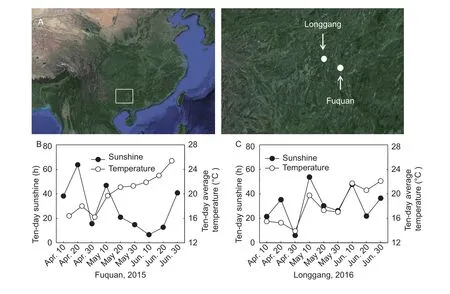
Fig. 1 Locations of two experimental sites in Guizhou Province, China (A) and 10-day sunshine and average temperature from Apr. to Jun. at Fuquan in 2015 (B) and Longgang in 2016 (C).
For the seedling survival rate assay, seedlings of both treatments that were alive after transplanting to the test plot for 40 d that were surveyed to calculate: The seedling survival rate (%)=Number of alive seedlings/Number of total test seedlings×100
2.3. Measurements of sucrose, glucose and fructose
The contents of sucrose, glucose, fructose and starch were determined by derivatization through trimethyl chlorosilane and hexamethyl disilylamine, followed by gas chromatographic detection under flame ionization detector(FID) mode, as described by Caiet al. (2012). Briefly, leaf samples collected after different treatments for 2, 7, 14 and 21 d as indicated were freeze dried, and 1.0 g dry weight was ground to a fine powder (0.45 mm), following extraction for 60 min with 50% (v/v) acetonitrile by shaking. After settling,6 mL of supernatant was filtered through a 0.45-μm filter. The contents of sucrose, glucose and fructose were measured simultaneously using a TRACE TR-5 Column (60 m×0.25 mm×0.25 μm) (Thermo, Waltham, MA, USA).
2.4. Quantification of nicotine
Nicotine levels in dried leaves of the transgenic plants were quantified by gas chromatography (GC) according to Caiet al. (2012). Each sample was prepared by placing(0.2000±0.0010) g of dried ground tobacco leaves into a 50-mL Erlenmeyer flask. A 2-mL of 2 mol L-1NaOH solution was added to each flask and swirled to moisten the tobacco.After 15 min of rest, 10 mL of methyl tertiary butyl ether(MTBE) containing 0.1062 g mL-1of quinoline was added to the flask. The flasks were placed on a shaker for 2.5 h.After being shaked, the flasks were allowed to sit overnight to separate. Approximately 1 mL of the top MTBE layer was transferred into a vial. GC analysis was conducted using split injection (40:1) on an Agilent HP 6890 GC-FID(Agilent Technologies, Santa Clara, CA) using a 30-m DB-5MS Column (0.53-mm i.d. and 1.5-μm film thickness). The carrier gas was helium at a linear velocity of approximately 38 cm s–1. The injector and detector were both set at 250°C.The analysis consisted of a temperature program from 110°C initially held for 0.5 min followed to 280°C at a rate of 25°C min–1, where the final temperature was held for 20 min. Data were collected and analysed using Agilent Chemstation Software (Agilent, Palo Alto, CA, USA). A multipoint internal standard calibration table was constructed for nicotine. The curve for nicotine was as follows:
Y=0.232779X+0.00805332
Where,Yrepresented the peak area ratio of nicotine-toquinoline standard, andXrepresented concentration ratio of nicotine-to-quinoline standard.
2.5. Assay of antioxidant enzyme activity
For the detection of antioxidant enzyme activities, fully expanded leaves (0.5 g) were ground in liquid nitrogen and extracted in 5 mL of Tris-HCl Buffer (50 mmol L–1,pH 7.0) containing 1 mmol L–1EDTA-Na2and 1% (w/v) soluble polyvinylpyrrolidone. The homogenates were centrifuged(10 000×g, 30 min, 4°C), and the supernatant was collected and used for the assay of enzyme activities as described by Linet al. (2013). Superoxide dismutase(SOD, E.C.1.15.1.1) activity was determined by measuring its ability to inhibit photochemical reduction of nitroblue tetrazolium (NBT). The reaction mixture was 50 mmol L–1sodium phosphate buffer (pH 7.3), methionine(13 mmol L–1), NBT (75 mmol L–1), EDTA (0.1 mmol L–1),riboflavin (4 mmol L–1) and 0.1 mL of the extract. One unit of SOD was defined as the amount of enzyme that produced 50% inhibition of NBT reduction.
Peroxidase (POD, E.C. 1.11.1.7) was assayed as follows: The reaction mixture contained 1.8 mL of 100 mmol L–1sodium phosphate buffer (pH 6.0), 0.1 mL guaiacol,0.1 mL of 12 mmol L–1H2O2and 0.1 mL of leaf extract. The formation of the conjugate product of guaiacol was measured at 460 nm. The increase in OD436was measured using an extinction coefficient of 26.6 mmol L–1cm–1for the conjugate as it was formed.
For catalase (CAT, E.C.1.11.1.6) activity determination,the decomposition of H2O2was followed at 240 nm in a quartz cuvette (extinction coefficient of H2O2was 0.04 mmol L–1cm–1). The reaction mix consisted of 2.7 mL of 0.1 mol L–1sodium phosphate buffer (pH 7.0), 0.1 mL of 300 mmol L–1H2O2solution and 0.2 mL of the extract. All experiments were performed in triplicate for each treatment.
2.6. Determination of dry weight and root volume
The whole seedlings were collected and rinsed with deionized water, surface dried, and subsequently dried at 80°C for 48 h to obtain dry weight. Root volume was determined by water displacement according to Burdett(1979). The plant root ratio was calculated as:
Root ratio (%)=Dry weight of root/Dry weight of root and shoot×100
2.7. Statistical analysis
Statistical analysis were performed using SPSS-17. The data were first subjected to analysis of variance, and differences in means between treatments were separated by the least significance difference (LSD) test at 0.05 probability.The data were presented as the means with standard errors(SE).
3. Results
3.1. Effects of high-temperature plastic mulching film-induced leaf burning on seedling growth
Generally, although leaf area of stressed seedlings with leaf burning was significantly increased compared to that of control seedlings after transplanting for 40 d at both sites in two years, fewer differences were detected between control and heat-stressed seedlings in plant height and leaf number(Figs. 2-C, E, F and 3). However, the two-year seedling survival rate at two independent study sites showed that leaf burning significantly increased the seedling survival rate (Fig. 2-D).
3.2. Effects of high-temperature plastic mulching film-induced leaf burning on the contents of fructose,glucose and sucrose in leaf and root
As the results shown in Fig. 4, in seedlings with leaf burning,the leaf contents of fructose and glucose increased sharply with the extension of sunshine time and the increase in temperature compared to those of control seedlings at two sites in two years and peaked at 11:00, followed by a gradual decrease until reaching the values of the control seedlings (Fig. 4-A, B, G and H). However, there was a time lag between the peaks in the leaf contents of fructose,glucose and sucrose. The sucrose increased to its highest value at 13:00 in a short time (Fig. 4-C and I).
The root fructose and glucose contents peaked at 13:00,regardless of leaf burning (Fig. 4-D, E, J and K). Moreover,leaf burning decreased the root sucrose content compared to control seedlings (Fig. 4-E). These results displayed similar trends at both sites in the two years.
3.3. Effects of high-temperature plastic mulching film-induced leaf burning on the content of nicotine in leaf and root
Although the content of nicotine in roots was higher than that of leaves in control seedlings, they did not change in this study at either site in two years (Fig. 5). Both leaf and root nicotine contents were increased sharply at 13:00 when seedlings leaf was burnt by mulching film. However, the nicotine content then decreased drastically less than that of the control in roots (Fig. 5-B).
3.4. Effects of high-temperature plastic mulching film-induced leaf burning on the activities of POD,SOD and CAT
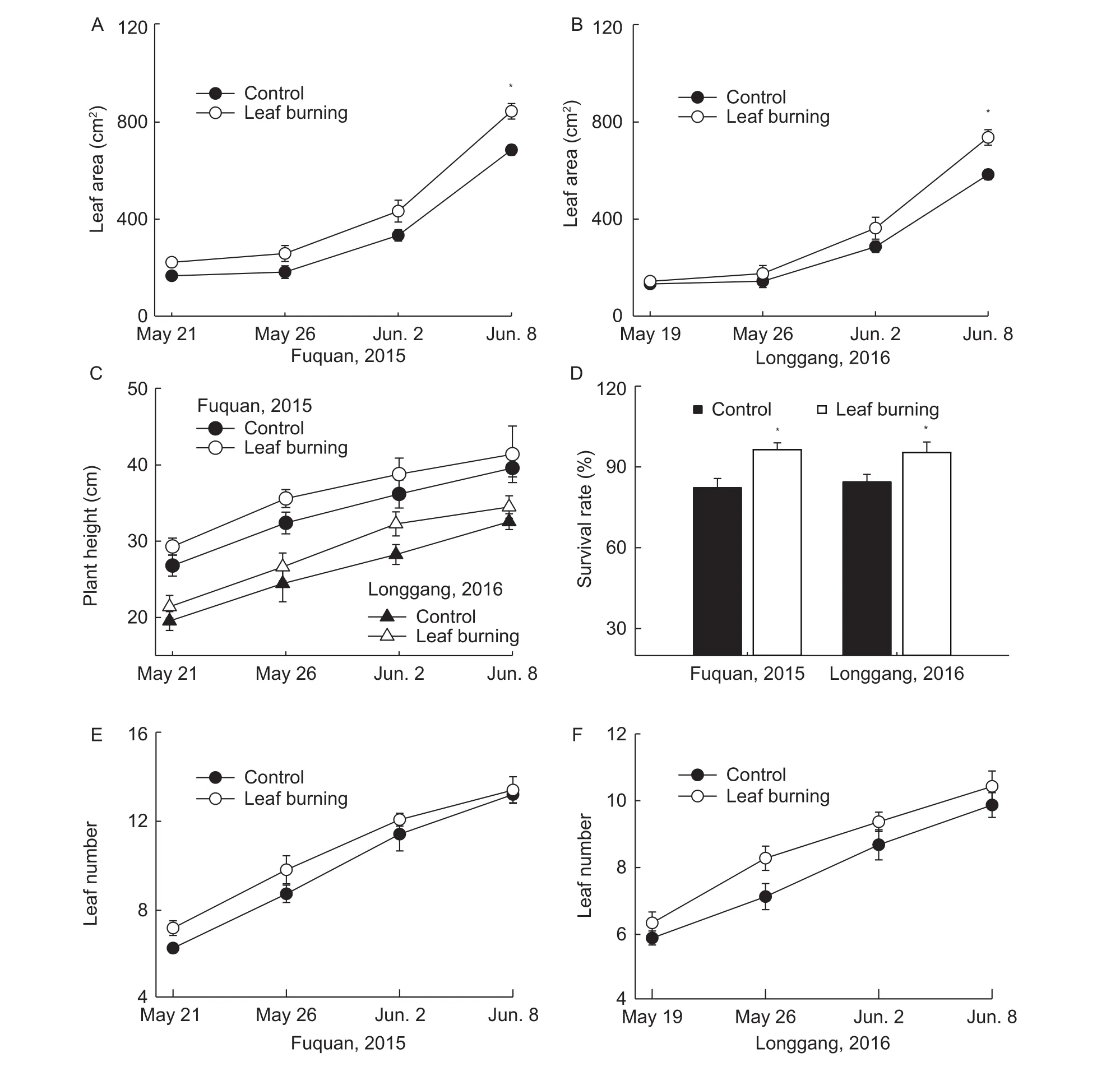
Fig. 2 Effects of plastic mulching film-induced leaf burning on seedlings growth (A and B, leaf area; C, plant height; D, survival rate; E and F, leaf number). Values represent the mean±SE (n=5). *, significant differences at P<0.05.
In the leaves of those seedlings that were burned by hightemperature plastic mulching film, the activities of POD and SOD were increased significantly compared to those of control seedlings in both 2015 and 2016 at two sites(Fig. 6-A and B). For SOD, although high-temperature plastic mulching film-induced leaf burning increased its activity slightly in 2016 at Longgang, its activities were increased significantly compared to those of the control seedlings in 2015 at Fuquan (Fig. 6-C).
3.5. Effects of high-temperature plastic mulching film-induced leaf burning on plant growth
Growth in dry matter increased with plant growth, but less dry matter accumulated in seedlings with leaf burning compared to the control in both 2015 and 2016 at the two independent study sites (Fig. 7). However, the difference between these two treatments was not significant. Moreover, mulching film-induced leaf burning increased the overall proportion of root biomass compared to control seedlings in both years at the two independent study sites (Fig. 7). Root volume increased with leaf burning caused by mulching film during the experiment (Fig. 8).
4. Discussion

Fig. 3 Phenotype of tobacco seedlings in Fuquan,Guizhou Province, China. Seedlings were transplanted at Apr. 29, 2015 and the pictures taken date were marked. The arrow indicates the burning leaf.
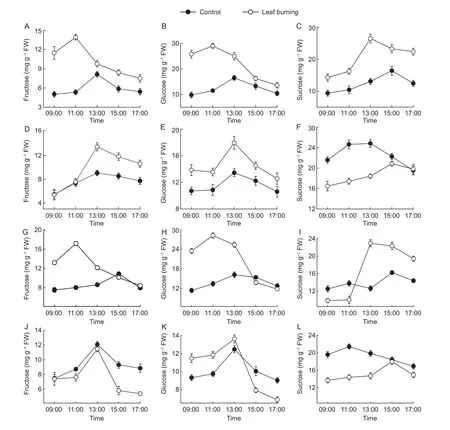
Fig. 4 Contents of fructose (A, D, G and J), glucose (B, E, H and K) and sucrose (C, F, I and L) in seedling leaves (A, B, C, G,H and I) and roots (D, E, F, J, K and L) at different times on a sunny day. A-F and G-L mean the results at Fuquan, Guizhou Province, China on May 20, 2015 and at Longgang, Guizhou Province, China on May 18, 2016, respectively. FW, fresh weight.Values represent the mean±SE, n=5.
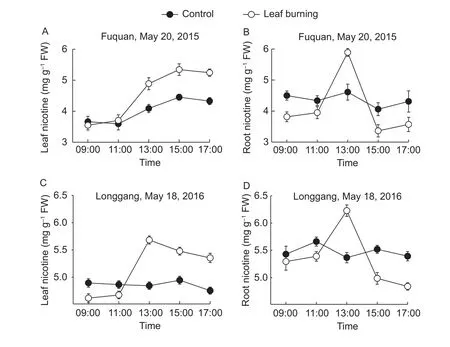
Fig. 5 Nicotine contents in seedling leaves (A and C) and roots (B and D) on a sunny day at Fuquang and Longgang experimental sites in Guizhou Province, China. FW, fresh weight. Values represent the mean±SE, n=5.
Plastic film mulching has been used widely to conserve water, increase temperature, control weeds, disease and insects, harvest early, and increase yields in modern agriculture (Wanget al. 2016; Zhanget al. 2016; Jiaet al.2017). However, there are limitations and pitfalls such as the burning of young leaves during tobacco seedling transplanting, which is always a frustrating experience,combined with the fact that to our knowledge, there is no report on the effects of leaf burning on seedling growth arising from high-temperature plastic mulching film. In this study,to identify the effects of high-temperature plastic mulching film-induced leaf burning on seedling growth and survival after transplanting, seedling growth and physiological responses of leaves that were burned by high-temperature plastic film mulching were compared at two experimental sites in two years. Our findings clearly demonstrate that leaf burning induced by high-temperature plastic mulching film did not hinder but improved seedling growth with an earlydeveloped root system after transplanting, which overturned the stereotypic view that leaf burning is negative to plant growth. Moreover, the involvement of sugar and nicotine in plant responses to leaf burning was also highlighted in the present study.
It was demonstrated that the use of plastic film mulching could enhance the daily mean temperature of the soil surface and 5–10 cm soil layer by 2–3°C within 5 d after tobacco seedling transplanting (Buet al. 2013), which allowed earlier transplanting as well as faster growth early in the growing season. However, the surface temperature can increase drastically in a short time in a sunny day, which might scorch seedling leaves that touched the plastic film mulching and cause economic losses in various species. However, in tobacco seedlings, the plant height of seedlings with leaf burning was higher with more leaves and significantly increased leaf area compared to those of seedlings without leaf burning, combined with the significantly increased seedling survival rate after transplanting for 60 d (Figs. 2 and 3), indicating that leaf burning induced by high-temperature plastic film mulching would not handicap tobacco seedling adaptation and growth potential. The results demonstrated that tobacco seedlings even benefit from this, which is contrary to the popular belief that high-temperature plastic mulching film-induced leaf burning is negative for seedling growth.
A key adaptive mechanism in many plants grown under abiotic stresses, including salinity, water deficit and extreme temperatures, is the accumulation of certain organic compounds of low molecular mass, generally referred to as compatible osmolytes (Hareet al. 1998; Sakamoto and Murata 2002). Under stress, different plant species may accumulate a variety of osmolytes, including soluble sugars,and the accumulation of such soluble sugars under heat stress has been reported in sugarcane, which has great implications for heat tolerance (Wahid and Close 2007). The increased accumulation of glucose, fructose and sucrose was detected as the prolonged sun exposure and increased surface temperature of plastic film mulching (Fig. 4) may contribute to enhanced stress tolerance of tobacco seedlings in our study by regulating the expression of thousands of genes and controlling the metabolic processes of growth(Wahid and Close 2007). The increased content of glucose and fructose might result in an increase in sucrose content with a 2-h lag in seedlings with leaf burning.

Fig. 6 Enzyme activities of peroxidase (POD, A), superoxide dismutase (SOD, B) and catalase (CAT, C) in tobacco seedling in Guizhou Province, China. Leaves were collected at 17:00 on May 20, 2015 at Fuquan and on May 18, 2016 at Longgang experimental sites, respectively. FW, fresh weight. Values represent the mean±SE, n=5. *, significant differences at P<0.05.
Plant tolerance to heat stress proved to be entirely dependent on the signalling flow of information by which the plant can sense the changes in its surrounding environment.In addition to its fundamental role in cells, sugar, particularly sucrose, has also been identified as a component of shooto-root signalling and regulates adaptive root development(Puiget al. 2012). Leaf burning results in a large, rapid increase in sucrose in burnt leaves and a smaller, delayed increase in the nicotine-synthesizing roots. Nicotine is a major inducible defensive compound that is very important in the chemical defence system in tobacco (Baldwin 1999).It is synthesized in roots and transported to other parts of the tobacco plant. InNicotiana sylvestrisplants, leaf damage increases the nicotine concentration of undamaged leaves fourfold, and this increase is due to a large increase in the nicotine concentration of the xylem fluid exported from the roots (Baldwin 1989, 1997). In the present study, the highest content of nicotine was recorded in both roots and shoots at 13:00 in seedlings with leaf burning (Fig. 5), when the content of sucrose was the highest in shoots (Fig. 4-C).Thus, we hypothesized that sucrose signalling triggered the biosynthesis of nicotine in roots after leaf burning. Then,nicotine, the principal alkaloids of tobacco, which are known for its functions related to protection and plant growth regulation, initiated physiological and biochemical responses that benefit plant growth and survival after leaf burning,regulating antioxidant enzyme activities, for example.
As a natural antioxidant, nicotine plays an important role in protecting plant cells against oxidative stress. The enzyme SOD scavenges super-oxygen ionsgenerated during metabolism and is thus a key enzyme in cellular defence,generating H2O2(Gechevet al. 2006), which then can be catalysed into hydrogen oxide by POD. The activities of SOD and POD were both increased significantly in seedlings with leaf burning at two experimental sites in two years in the present study, combined with the increased activity of CAT,which is active only at relatively high H2O2concentrations(Gechevet al. 2006), indicating that antioxidants of seedlings with leaf burning were more effective compared to those of the control.
Roots are the principal site of nutrition and water uptake.The plant dry mass and root/shoot ratio in seedlings with leaf burning were both increased compared to those of the control at two independent study sites in two years (Fig. 7),suggesting that there was an increase in the whole plant allocation of biomass to roots in leaf burning seedlings.This suggests changes in regulatory mechanisms that determine root/shoot ratio allocation possibly caused by leaf burning arising from high-temperature plastic mulching film. Combined with the increased root volume (Fig. 8) and accompanying increased root surface areas in seedlings with leaf burning, plants’ ability to absorb water and nutrients from soil would be facilitated, and its growth and tolerance to adverse environment were improved.
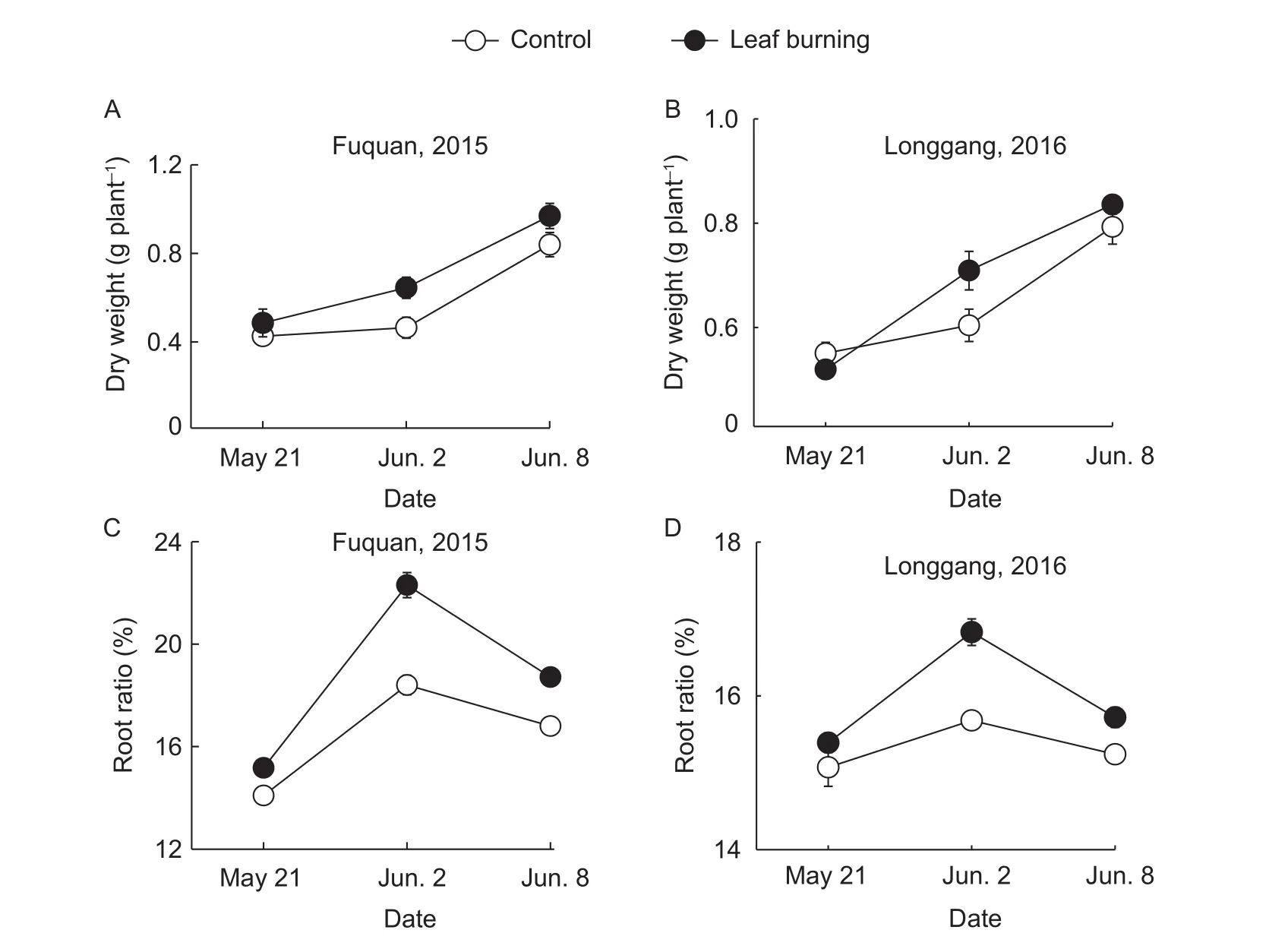
Fig. 7 Dry weight (A and B) and root ratio=Dry mass of root/Dry weight of root and shoot×100 (C and D), of tobacco seedlings with or without leaf burning at different times as indicated after being transplanted in Fuquan (A and C) and Longgang (B and D),Guizhou Province, China in 2015 and 2016. Values represent the mean±SE, n=5.
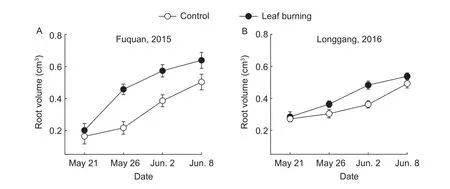
Fig. 8 Root volume of tobacco seedlings after being transplanted in Fuquan (A) and Longgang (B) experimental sites, Guizhou Province, China in 2015 and 2016. Values represent the mean±SE, n=5.
As tillering or root systems of lawn are improved after defoliation when gardening, different species’ responses to mechanical wound, herbivory attack and leaf burning vary. For tobacco seedlings in the present study,positive effects on plant growth, especially root system development, were detected when the leaf was burnt by high-temperature plastic mulching film. Thus, these new findings prove that leaf burning induced by hightemperature plastic mulching film after transplanting in a ridge-furrow system during tobacco cultivation is positive for seedling adaptation and growth, which was contrary to the stereotype view that leaf burning was negative for plant growth.
5. Conclusion
Our research demonstrated that the leaf burning resulted from high-temperature plastic mulching film did not inhibite but improve seedling survival and growth in the early developed root system. Furthermore, we also detected that the contents of sugar and nicotine were increased in plant response to leaf burning, highlighted their contribution in enhancing plant physiological and biochemical adaptation.Although further study will be required, the present study provides us with a deeper understanding of leaf burning induced by high-temperature plastic mulching film in the first week during tobacco cultivation.
Acknowledgements
The authors are grateful to Dr. Cai Kai (Guizhou Academy of Tobacco Science, China) for assistance in analyzing sugars and nicotine in tobacco. This study was supported by the Science and Technology Foundation of Guizhou Province,China (20146015-2, 20152099 and 20161097), the Special Fund for Excellent Young Talents of Guizhou Province,China (201534), and the Foundation of Guizhou Academy of Tobacco Science, China (GZYKS2018-02).
Baldwin I T. 1989. Mechanism of damage-induced alkaloid production in wild tobacco.Journal of Chemical Ecology,15, 1661–1680.
Baldwin I T. 1997. Allometric limits to the induced accumulation of nicotine in native tobacco.Plant Species Biology,11,107–114.
Baldwin I T. 1999. Inducible nicotine production in nativeNicotianaas an example of adaptive phenotypic plasticity.Journal of Chemical Ecology,25, 3–30.
Bu Y H, Zhang Y C, Hu X D, Chen G. 2013. Effects of transplanting small seedling under plastic film mulching on growth and development of flue-cured tobacco.Acta Agriculturae Jiangxi,25, 157–160. (in Chinese)
Burdett A N. 1979. A nondestructive method for measuring the volume of intact plant parts.Canadian Journal of Forest Research,9, 120–122.
Cai K, Xiang Z M, Zhang J, Zhou S P, Feng Y G, Geng Z L.2012. Determination of eight tobacco alkaloids in flue-cured tobacco samples by gas chromatography with nitrogen chemiluminescence detection (NCD).Analytical Methods,4, 2095–2100.
Gechev T S, Van Breusegem F, Stone J M, Denev I, Laloi C.2006. Reactive oxygen species as signals that modulate plant stress responses and programmed cell death.BioEssays,28, 1091–1101.
Hancock J M, Simpson D. 1995. Methods of extending the strawberry season in Europe.HortTechnology,5, 286–290.
Hare P D, Cress W A, Staden J V. 1998. Dissecting the roles of osmolyte accumulation during stress.Plant Cell Environment,21, 535–553.
Ingman M, Santelmann M V, Tilt B. 2015. Agricultural water conservation in China: Plastic mulch and traditional irrigation.Ecosystem Health and Sustainability,1, 1–12.
Jabran K, Hussain M, Fahad S, Farooq M, Bajwa A A, Alharrby H, Nasim W. 2016. Economic assessment of different mulches in conventional and water-saving rice production systems.Environmental Science and Pollution Research,23, 9156–9163.
Jia H C, Zhang Y, Tian S Y, Emona R M, Yang X Y, Yan H R,Wu T T, Lu W C, Siddiqued K H M, Han T F. 2017. Reserving winter snow for the relief of spring drought by film mulching in northeast China.Field Crops Research,209, 58–64.
Lamont W J. 1993. Plastic mulches for the production of vegetable crops.HortTechnology,3, 35–39.
Li F M, Song Q H, Jjemba P K, Shi Y C. 2004. Dynamics of soil microbial biomass C and soil fertility in cropland mulched with plastic film in a semiarid agro-ecosystem.Soil Biology Biochemistry,36, 1893–1902.
Lieten P, Hokanson S, Jamieson A. 2002. Protected cultivation of strawberries in Central Europe. Strawberry research to 2001. In:Proceedings of the 5th North American Strawberry Conference. American Society for Horticultural Science(ASHS) Press, Alexandria. pp. 102–107.
Lin Y C, Chen D, Paul M, Zu Y G, Tang Z H. 2013. Loss-offunction mutation ofEIN2inArabidopsisexaggerates oxidative stress induced by salinity.Acta Physiologia Plantarum,35, 1319–1328.
Lin Y C, Chen W, Chen Y, Gao W C, Ding F Z, Li H X, Liang G L, Pan W J. 2015. Effects of well-cellar style transplanting on growth and photosynthetic characteristics of flue-cured tobacco seedlings.Journal of China Agricultural University,20,120–126. (in Chinese)
Liu E K, He W Q, Yan C R. 2014. ‘White revolution’ to ‘white pollution’ - Agricultural plastic film mulch in China.Environmental Research Letters,9, 1–3.
Masny A, Zurawiez E. 2015. Season extension possibilities in two Polish June - Bearing strawberry cultivars.Acta Scientiarum of Polonorum-Hortorum Cultus,14, 115–127.
Mu?oz K, Buchmann C, Meyer M, Schmidt-Heydt M,Schaumann G E. 2017. Physicochemical and microbial soil quality indicators as affected by the agricultural management system in strawberry cultivation using straw or black polyethylene mulching.Applied Soil Ecology,113,36–44.
Puig J, Pauluzzi G, Guiderdoni E, Gantet P. 2012. Regulation of shoot and root development through mutual signaling.Molecular Plant,5, 974–983.
Sakamoto A, Murata N. 2002. The role of glycine betaine in the protection of plants from stress: Clues from transgenic plants.Plant Cell Environment,25, 163–171.
Schonbeck M W. 1999. Weed suppression and labor costs associated with organic, plastic, and paper mulches in small-scale vegetable production.Journal of Sustainable Agriculture,13, 13–33.
Wahid A, Close T J. 2007. Expression of dehydrins under heat stress and their relationship with water relations of sugarcane leaves.Biologia Plantarum,51, 104–109.
Wahid A, Gelani S, Ashraf M, Foolad M R. 2007. Heat tolerance in plants: An overview.Environmental and Experimental Botany,61, 199–223.
Wang Y P, Li X G, Zhu J, Fan C Y, Kong X J, Turner N C,Siddique K H M, Li F M. 2016. Multi-site assessment of the effects of plastic-film mulch on dryland maize productivity in semiarid areas in China.Agricultural and Forest Meteorology,220, 160–169.
Zhang D, Liu H B, Hu W L, Qin X H, Ma X W, Yan C R, Wang H Y. 2016. The status and distribution characteristics of residual mulching film in Xinjiang, China.Journal of Integrative Agriculture,15, 2639–2646.
Zhou L, Li F, Jin S, Song Y. 2009. How two ridges and the furrow mulched with plastic film affect soil water, soil temperature and yield of maize on the semiarid Loess Plateau of China.Field Crops Research,113, 41–47.
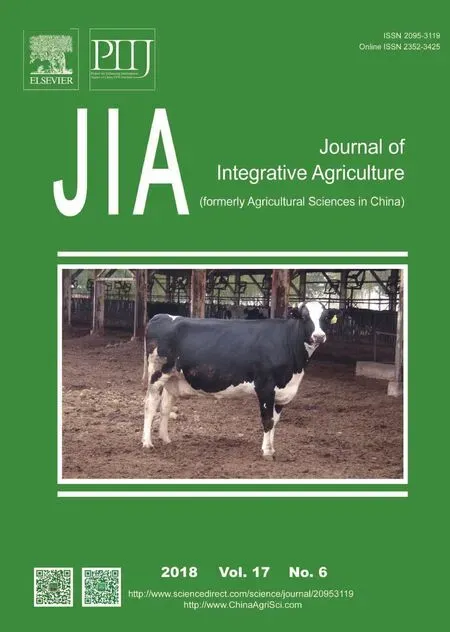 Journal of Integrative Agriculture2018年6期
Journal of Integrative Agriculture2018年6期
- Journal of Integrative Agriculture的其它文章
- Improve access to the EU market by identifying French consumer preference for fresh fruit from China
- Factors influencing hybrid maize farmers’ risk attitudes and their perceptions in Punjab Province, Pakistan
- Long-term grazing exclusion influences arbuscular mycorrhizal fungi and their association with vegetation in typical steppe of lnner Mongolia, China
- Soil microbial characteristics and yield response to partial substitution of chemical fertilizer with organic amendments in greenhouse vegetable production
- Reducing nitrogen fertilization of intensive kiwifruit orchards decreases nitrate accumulation in soil without compromising crop production
- Ultrastructure of the sensilla on antennae and mouthparts of larval and adult Plutella xylostella (Lepidoptera: Plutellidae)
